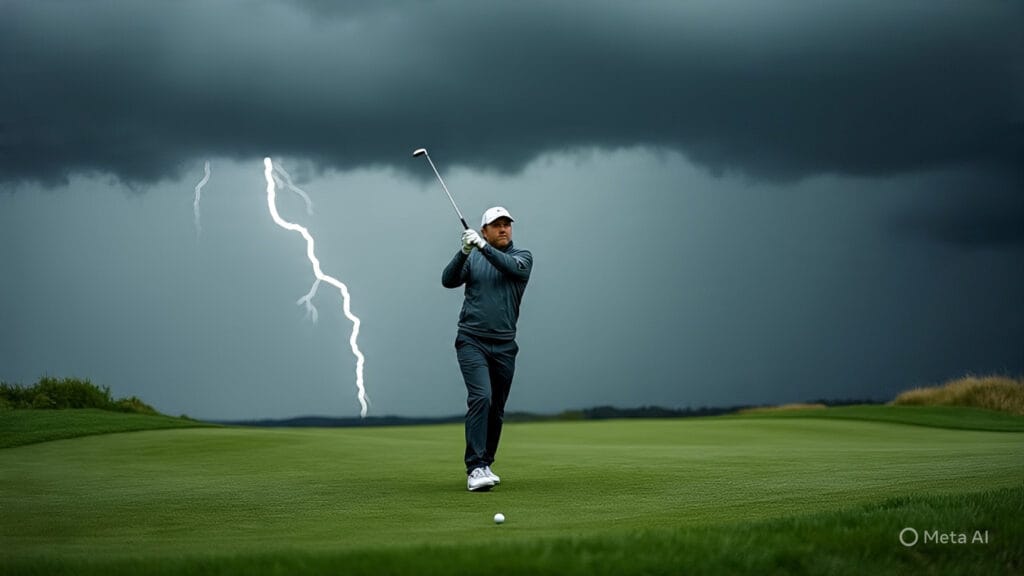Top Takeaways and Key Concepts
Please Note: This post may contain affiliate links. If you click one of them, we may receive a commission at no extra cost to you. As an Amazon Associate, I earn from qualifying purchases.
→ Plan each hole strategically by studying course layout, hazards, and yardage before every round.
→ Play within your skill level and choose clubs suited to your realistic shot distances.
→ Prioritize smart shot selection over distance to minimize risks and stay consistent.
→ Use practice rounds effectively to test strategies and learn how the course behaves.
→ Analyze past mistakes to adjust your approach, strengthen weaknesses, and build confidence.
Summary of This Article
Effective golf course management is about strategy, patience, and decision-making—not just power. This article teaches how to plan each shot, play to your strengths, and use practice rounds to develop smarter game strategies. You’ll learn how to stay calm under pressure and make decisions that lower scores while keeping the game fun.
If you've ever stood on the tee box and looked down a fairway that looked more like an adventure movie than a golf course, you know what I mean. Managing the course is really important. It's not enough to just hit the ball as hard as you can. It's about how you shoot.
I recall my pal thinking he could drive over this large water hazard. He swung hard, and then there was a splash. We didn't know what had happened until he was swimming with the fish instead of playing his game. We still chuckle about it, but it truly demonstrates how crucial it is to plan ahead.
Knowing when to take risks and when to play things safe is what it means to be wise. Sometimes, it's better to stay there and avoid a danger than to try to get past it and get into trouble. You need to find out where the difficulty areas are and plan your shots around them.
Think of each hole as a puzzle. What steps do you need to take to fix it? There might be a good place on the fairway that will make it easy for you to hit your approach shot. Or maybe there's a tree in your way that you should stay away from instead of trying to get past it.
Take a moment before each swing the next time you're out there. Think about where you want the ball to go and what is in its path. It really does make a difference! Play smarter, get better scores, and who knows, you could even have more fun!
What Is Course Management?

First things first, what do we mean by “course management”? In short, it's making smart choices during your round to cut down on mistakes and increase your chances of scoring.
It's like trying to get through a maze while blindfolded. If you don't have a plan, you could end up stranded in a corner thinking about your life choices.
Good course management starts before you even get to the first tee, by the way. Get to know the course's layout by learning where the hazards are and what each hole needs.
This information is like having GPS for your golf game! Are there bunkers hiding around every corner? Is that pond just asking for a stray shot? It's easier to plan your shots when you know these things.
It's interesting that a lot of golfers don't pay attention to this important part of their game. They just think about swing mechanics or equipment, but strategy is just as crucial.
The next time you're at your favorite course, take a look at the scorecard. It could help you avoid extra strokes and heartbreak.
Assessing Your Skill Level

Understanding your own skill level is vital for effective course management. You wouldn’t try to hit a 300-yard drive if your average distance is closer to 200 yards—unless you're feeling particularly brave or foolish! Be realistic about what clubs and shots work best for you under different circumstances.
For instance, during one memorable round with my buddy Dave (who claims he can “drive like Tiger Woods”), he decided to go for an impossible par-5 green in two shots after barely clearing the last water hazard.
Spoiler alert: his ball ended up in another state entirely! It was hilarious at first but also serves as a cautionary tale about knowing one's limits.
To be fair, this doesn’t mean you should shy away from challenges altogether; rather, approach them intelligently based on past experiences and current abilities.
If you've been struggling with your driver lately but excel at using hybrids off the tee? Use that hybrid instead! Playing within your skill set will lead to fewer disasters—and hopefully fewer lost balls.
Developing Shot Selection Strategies

A lot of golfers either do incredibly well or really horribly at this point, so let's talk about how to pick the appropriate stroke. The most important thing is to carefully choose the club based on the distance, the wind, and the lay.
Honestly, it's better to play it safe than to try for glory shots that could cost you a lot of strokes and make you look horrible.
For instance, if I have to smash an uphill approach shot over woods to get to a pin that is tucked away, do I really need my 9-iron, or would it be better to just lay up short?
It's amusing because I saw someone do this once and their ball bounced off trees like they were trying out for “America's Got Talent.” What did we take away from this? Choose intelligently based on the situation, not your pride!
There are also times when hitting safely onto the greens is better than trying for the flag every time. You'll see that it's much easier to get pars when you always putt from a good distance instead of always scrambling out of difficulty!
Utilizing Practice Rounds Effectively

Speaking of practice rounds, they're not just for getting better at a game; they're also great chances to come up with good strategies for certain courses!
Use these sessions to try out new things without feeling rushed so that everything feels familiar on tournament day (or any other weekend).
During one very eye-opening practice round at our local track, which we affectionately call “the beast,”
I played with two friends who persisted on trying any insane shot they could think of, like flop shots over trees and straight into bushes, or heroic attempts to carry water hazards without thinking about what would happen beforehand!
What happened? We had a great time in the afternoon, but then we lost a lot of balls. Every time we went back, we learned how to make better decisions in the future.
So, make sure that every practice session is useful by making goals that focus on fixing problems and coming up with good strategies that are based on your strengths and limitations that you have seen in your past gameplay experiences!
Learning From Mistakes

Oh exactly, the blunders we all make on the course that we hate! But here's something interesting: if you look at your mistakes the right way, they might help you improve.
Instead of being sad after hitting another chip shot into the ground or worse, let's figure out what went wrong so we don't do it again (or make things worse).
Thinking about the mistakes I've made has definitely helped me learn. When things get hard, you need to be patient. You don't always have to smash the ball hard; sometimes you need to be soft. For example, when you're chipping around the greens. It's not about hitting the ball as hard as you can. When the pin is on a slope and poised to roll away, accuracy is far more important than just aiming for it.
I recall once when I tried to chip over a bunker and ended up in it. Not fun! But that taught me to pay attention to how I'm hitting the ball, not just where I want it to go.
You know that even great golfers make mistakes? Everyone does. It's part of the game. A key step toward getting better is accepting your imperfections. Don't be too hard on yourself when you make a mistake. Just think about what went wrong and how you can make it better next time.
Keep at it! You can learn something new and become a better player every time you make a mistake. So the next time you're out there, keep this in mind: practice and patience are your best friends!
Conclusion: Play Smart Golf
Running a course isn't that hard. It sounds fancy, but it's actually simply about being clever and making excellent decisions on the course. Of course, it's fun to hit long drives. Who doesn't like that? But hitting the ball hard isn't all there is to golf.
To get good at this talent, you have to put in a lot of time and effort. You have to be ready to change as you play. There is something unusual about each round. The grass could be very thick, or the wind could be very fierce. There are things about each hole that can change how you should play.
It's like chess. You wouldn't just change things without thinking, would you? You would think ahead and plan your moves according on what you saw on the board. It's the same with golf!
You might have a lot more fun if you take the time to think about your options. Don't concentrate about how far you hit it; instead, think about where you want the ball to fall. That could include carrying an extra club to make the shot safer or aiming for a broader area of the fairway instead of going straight for a small target.
Every choice you make counts and helps you obtain fewer points! Using your brain makes the game more fun in general. When you're out there next time, remember this: it's not enough to be strong; you also need to have fun while doing a good job!
Featured Snippet: Smart golf course management means planning each shot with strategy, patience, and awareness. By assessing hazards, playing within your abilities, and focusing on smart shot selection, golfers can reduce mistakes, score lower, and enjoy the game more while improving consistency and confidence on every round.
Frequently Asked Questions
What does golf course management mean?
Golf course management is the strategy of planning each shot to minimize mistakes, manage risks, and improve scoring by making smarter decisions on the course.
Why is course management important in golf?
Good course management helps golfers avoid unnecessary hazards, control shot placement, and play more efficiently—leading to lower scores and a more enjoyable game.
How can I plan my shots better on the course?
Before each swing, evaluate yardage, wind, and obstacles. Choose the safest, most effective shot based on your strengths and the layout of the hole.
What’s the best way to use practice rounds effectively?
Practice rounds help you test strategies, learn course conditions, and adjust your play style without pressure, preparing you for competitive rounds.
Should I always aim for distance when playing golf?
No, accuracy and smart positioning are more important than distance. Playing conservatively often produces better results than risky long shots.
How can I learn from my mistakes on the golf course?
After each round, review what went wrong, note patterns in missed shots, and adjust your strategy or club choices accordingly for future improvement.
What’s the biggest takeaway from smart course management?
The key is playing with patience and awareness—using your brain as much as your swing to make every decision count.
Suggested Resources:
How To Improve Your Golf Game
https://www.golfdigest.com/story/how-to-improve-your-golf-game
The Importance Of Course Management
https://www.pga.com/news/golf-buzz/course-management-key-to-better-golf
Tips For Better Golf Strategy
https://www.golf.com/instruction/2020/01/21/tips-for-better-golf-strategy/

Kevin Collier is an avid golfer and contributing author at AIGolfTips.com, where he shares his passion for the game through expert tips, techniques, and gear reviews. With years of experience on the course, Kevin offers valuable insights for golfers of all skill levels, helping them improve their game and maximize their potential. Whether discussing swing mechanics or the latest in golf technology, Kevin's engaging approach aims to inspire and educate fellow golf enthusiasts to elevate their performance and enjoy every moment on the green.




